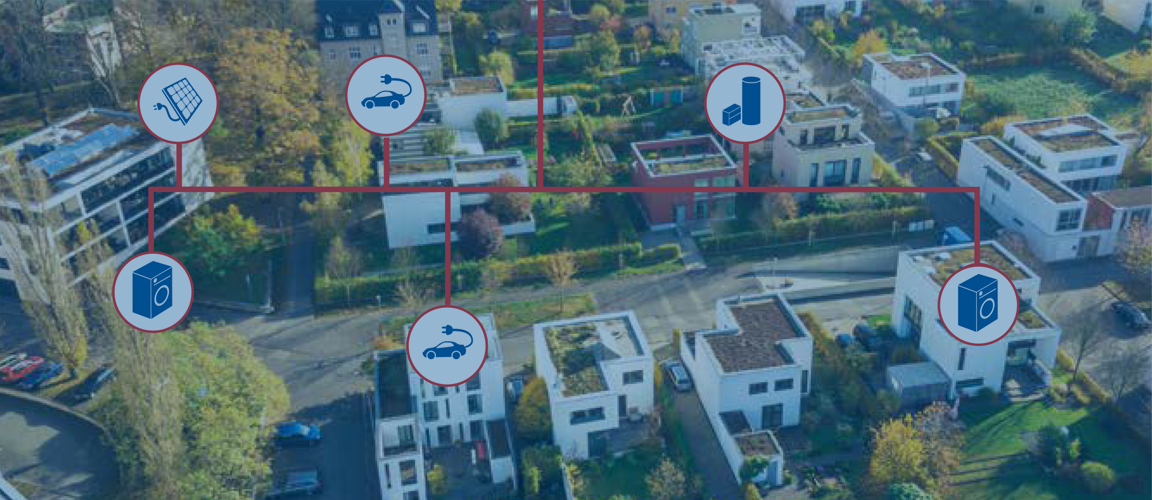
 Climate friendly quartersEnergy system transformation at home
Climate friendly quartersEnergy system transformation at home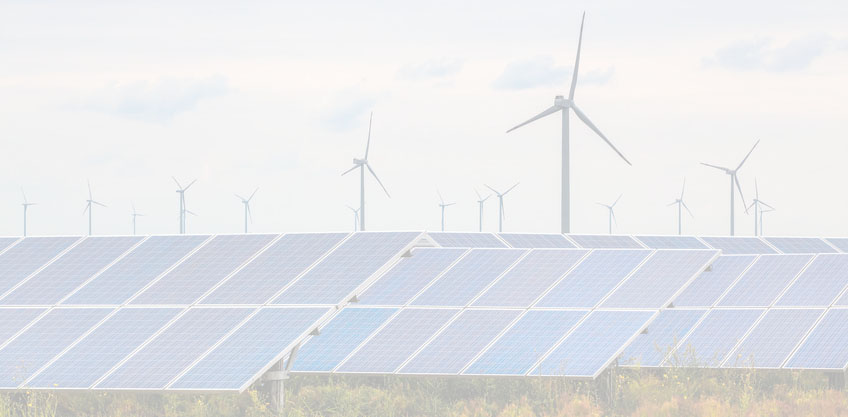 Easy Smart GridWe develop solutions to make energy systems more flexiblebased on innovative technology for higher shares of renewables and lower cost
Easy Smart GridWe develop solutions to make energy systems more flexiblebased on innovative technology for higher shares of renewables and lower cost
Climate friendly quarters
Citizens drive the change to green energy by their political choices and institutions, investments and living environment. Roughly two thirds of GHG emissions caused today by heating and mobility will be avoided by heat pumps and electric vehicles. Both bring the additional benefit of temporal flexibility: heat can cheaply be stored in water tanks, and vehicles are stationary longer than the time needed for recharging. They can adapt electricity consumption to the generation patterns of sun and wind, thus substituting electricity storage as low cost “virtual batteries”. We enable them to operate intelligently and efficiently in climate friendly quarters to create financial and climate benefits. Attractive conditions for such “local energy communities” have already been created by the European Commission.
Our offer
Communities, planners, project developers, construction companies, real estate owners and smart technology vendors aim to quickly and substantially reduce carbon footprints of existing and newly developed quarters. Our input is valuable for their work:
- Concepts and implementation of climate friendly quarters
- Future-proof technology for cost-optimal operation
- Know-how and experience from successful reference projects
- Provision of Easy Smart Grid technology (software, license)
- Technology transfer to component suppliers, system integrators and facility managers
Our real-world demo project “SoLAR Allensbach” has been selected for the “Good Practice Award of the Year 2021” by the Renewables Grid Initiative. RGI presented the winning project in the category “Technological Innovation & System Integration” in a webinar. If you like to know more on the organisation, its members, the jury and other competing and winning projects, follow this link .

Your benefits
- Attractive added value for end customers, operators, electric grid and climate protection
- Software upgrade, not ever more components (complexity, cost)
- Compatibility with EU requirements (dynamic end customer tariffs)
- Step-by-step migration and easy integration of new flexibility.
Please download our brochure here and contact us with your requirements!
Reference project SoLAR Allensbach
Our real-world lab demonstration “SoLAR Allensbach” will become fully operational in 2021 and demonstrates our approach, its implementation and benefits. Below we reproduce a slightly shortened report presented by project coordinator Stefan Werner at the 2nd innovation congress in Ulm/Germany that reflects the status of March 2021, contains also literature references and can be downloaded here. More detailed reports and a publication on dynamic tariffs in German are available on the German version of our web site. Project presentations can also be downloaded from an IEEE event and one by the European Heat Pump Association ehpa.
Project summary
The real-world lab project SoLAR in Allensbach (at Lake Constance/Germany) demonstrates the value of intelligent energy sector coupling. With a real-time price system based on electric grid state variables, flexible appliances of every type, power and availability can be used as “virtual batteries”. This solves the main challenge of energy system transformation: Renewable energy generation profiles that are volatile and do not match conventional consumption profiles. Minimum cost of energy storage and grid extension is ensured together with high availability, resilience and complexity of the energy system.
The project has been initiated by citizens engaging in climate protection and is supported by renowned research institutes and companies. It has been implemented in a new residential development with 22 households in 12 semi-detached houses and two apartment buildings (also integrating an existing building with three households). It includes rooftop PV, smart control of a CHP unit, 12 heat pumps, several household appliances, charging units for electric vehicles and stationary batteries. The objective is to increase its electricity self-consumption rate from 50 to over 80%.
Results so far show that the objective can be met. A follow-on project with the communal utility of Hassfurt is being prepared to demonstrate that the system can be scaled to a full distribution grid and will be economically sound. In this context also a tariff system including dynamic price components will be developed to enable intelligent energy sector coupling generally, maximise economic as well as individual benefits, and respond to already existing EU regulatory requirements.
Project report
„SoLAR“ (German abbreviation for “Smart Grid without load profile measurement Allensbach-Radolfzell”) was initiated by the Local Agenda 21 in Allensbach/Lake Constance, a citizen initiative for climate protection. It was financially supported by the Ministry for the Environment, Climate and Energy Industry of the German State of Baden-Wuerttemberg during the period 2018-21 through the “BWPLUS” funding programme.
Prior to this project, a climate protection guideline had been passed by the community in 2006, stating the objective of climate neutrality by 2050. With funds from the “Climate Neutral Communities“ competition, various analyses had been performed since 2010, including coupling of electricity and heating sectors. This showed that 80% of conventional electricity demand can be provided from solar and wind if integrated in the existing energy grid by intelligent coupling with CHP and heat pumps.
In 2016 the Local Agenda developed a concept (“Climate Plan”) to supply the community mainly from renewable energy sources, assuming that all energy sectors (electricity, heating and mobility) will be widely electrified and coupled intelligently. The community also got involved with the SINTEG project C/Sells (a smart grid demonstration project funded by the German Federal Government) where it served as a “participation cell” in its sociological analysis, citizen involvement being a major part of this project.
Figure 1 shows estimates of the required power of various energy installations in Allensbach to reduce CO2 emissions by 75%, relative to 2002. They assume the use of natural gas for CHP and suitable insulation measures for existing buildings.
For an economically feasible transformation, the plan aims to minimize battery storage and grid extension. This requires intelligent and real-time coordination of equipment responding to renewable energy availability. In the project application phase, the patented technology of Easy Smart Grid GmbH (ESG) for decentral energy management was identified as a suitable approach.
Figure 1
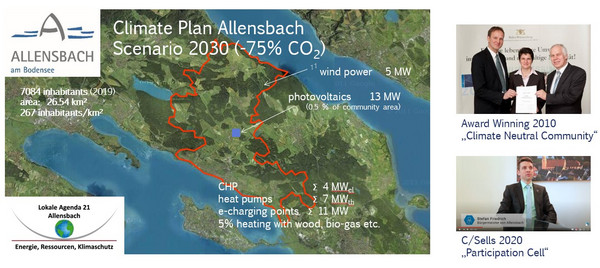
Figure 2 shows typical consumption profiles of European household appliances (source: University of Bonn) and their flexible adaptation to a typical renewable energy production profile by decentral energy management. Appliance flexibility depends on its available storage capacity, e.g. thermal storage in cooling devices, or customer flexibility, i.e. users willing to provide a time window until dishes are removed from a dish-washer that allows to shift the cleaning process in time. Such energy flexibility allows to use more renewable energies while respecting user constraints.
Figure 2
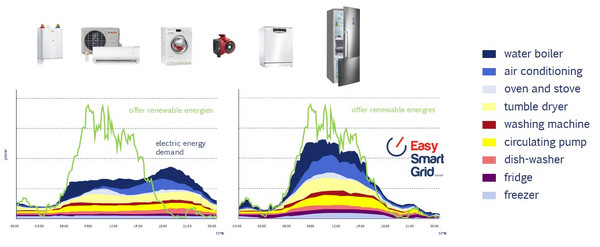
Changing appliance operating time has the same effect on the electric grid as absorbing surplus generation in a battery, and then providing it to appliances with unchanged operation. Intelligent control thus creates low-cost „virtual batteries “. An internal ESG estimate identified 50% of energy consumption in households, business and industry to be able to respond to renewable energy availability and create such virtual batteries.
Energy sector coupling can provide substantially more flexibility in the future if combined with intelligent control of CHP, heat pumps and EV charging, as illustrated in Figure 3 (based on input from Prof. Quaschning, HTW Berlin). While electricity consumption will grow significantly by sector coupling, it will also provide an estimated flexibility of 80% of future electricity consumption. At the same time efficiency gained by heat pumps, CHP and electric vehicles limit the required additional renewable generation capacity.
Periods without sun or wind are bridged by CHP in the Allensbach concept. Seasonal storage of renewable energy that will become necessary in the future may be achieved by replacing natural gas with hydrogen or synthetically produced methane.
To demonstrate feasibility and economic performance of intelligent energy sector coupling in SoLAR, Kaufmann GmbH/Oberstadion could be won as the owner and general contractor of a climate-friendly housing development in Allensbach. Kaufmann has built 12 semi-detached houses and two apartment buildings with a total of 22 households, constructed mainly with wood and insulated according to KfW-40 standards.
Figure 3
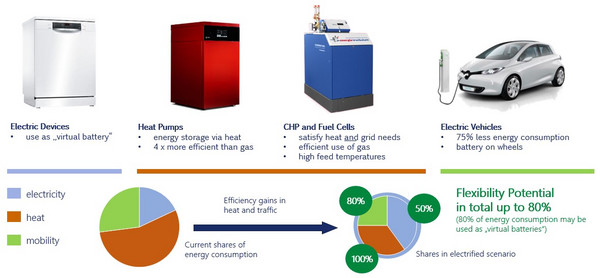
Figure 4 shows the area and the most relevant project partners. Scientific partners are the International Solar Energy Research Center (ISC) Konstanz and the European Institute for Energy Research (EIfER) from Karlsruhe. The private electricity grid will be operated by Energiedienst AG in Rheinfelden which also takes the roles of metering and energy supplier. Each semi-detached house has its own rooftop-PV and possibly a battery, the apartment buildings have PV installed by Energiedienst. Total installed PV capacity is around 80 kWp.
Figure 4
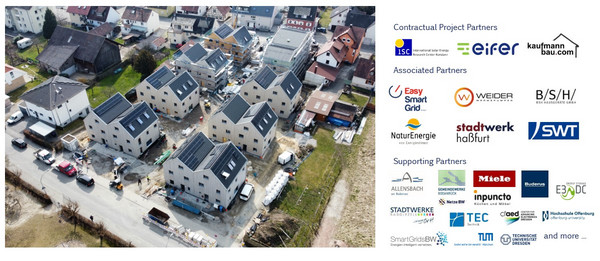
Figure 5 shows a cross-section of the basement with the connecting underground garage. 12 semi-detached houses marked in yellow are supplied by individual heat pumps. Ground water heat is shared by a distribution ring and can also be used for cooling. The apartment buildings and existing neighbouring building are supplied by a central 21 kWel CHP provided by Energiedienst. All heat generators are intelligently controlled, together with car charging points, household appliances and battery storage. In total up to 100 appliances may need to be coordinated, with the objective to increase self-consumption of locally produced electricity from 50 to over 80%.
Figure 5

The ESG principle of intelligent appliance control is sketched in Figure 6. A price signal is derived from the state of the electric grid, ideally every second. This price signal (balance indicator BI) is normalized between -1 and +1 and indicates energy surplus (low price) or scarcity (high price). Depending on objectives and business model, different grid states can be utilized: In isolated grids, energy imbalance can be identified from grid frequency at each location and translated into a BI. The SoLAR site is coupled to the public grid, so energy balance can be determined from energy flow (power) at the transformer interconnection point.
In addition to power balance, information on grid bottlenecks can be derived from voltage at a grid connection or current in a grid segment. These can also be translated into price signals (we call them Congestion Indicator CI) in the range -1 to +1. Several relevant price signals can be combined suitably to stimulate a response by customer devices.
Figure 6
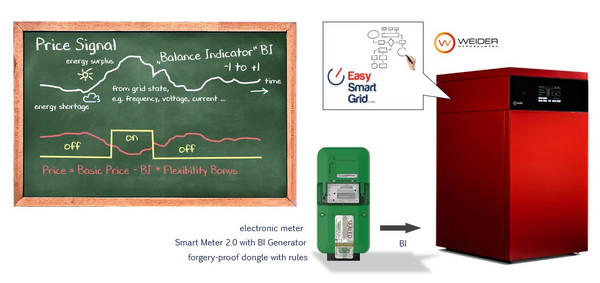
In the target scenario, the price signal is constructed in a smart meter from measurements taken (BI generator) or can be received there and forwarded to flexible appliances. The price construction formula can be provided by an encrypted software module to ensure cyber security.
Controllers of flexible devices decide autonomously on operation, choosing financially attractive periods constrained by their flexibility, without the need to exchange data with central controllers. The physical grid reaction to the appliances’ switching decisions constitutes the return channel.
Only low data rate price signals (~1 Byte/sec) are needed and algorithm implementation can be very lean, such that this functionality can be implemented within existing control units. At project end, the suppliers of heat pumps (Weider/Hard in Austria) and CHP (Energiewerkstatt/Hannover in Germany) will implement optimized algorithms directly in their controls.
Price signals will be only be used in SoLAR for operation optimisation, not actual billing. Future dynamic tariffs may directly convert price signals into energy prices (BI) or grid fees (CI) by multiplying them with a fixed “flexibility bonus” and adding this to a base price. The necessary values can be stored in a smart meter and exported after a measurement period as averaged or detailed data, depending on requirements.
Figure 7 and 8 show the effect of the price signal derived from power balance on the behaviour of heat generators at the site. Simulations of a “virtual demonstrator” for two-day periods are shown. A digital twin of the site was developed by EIFER that virtually represents it with all appliances. During 2021 these simulations will be validated in the demonstration site.
Figure 7
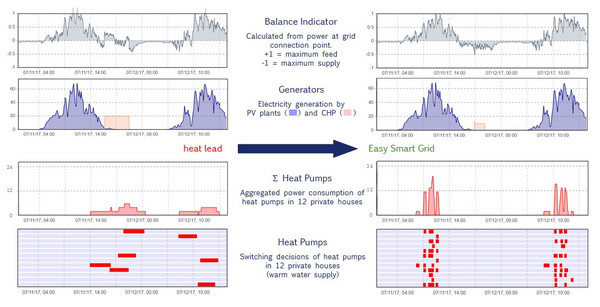
On the left-hand side, a typical two-point control keeps temperature in the hot-water buffer within a given range. On the right-hand side the controllers also receive and react to a price signal (BI). In summer (only hot water) heat pumps shift operation to times of maximum PV production. They learn when prices are attractive. Appliances with only partly filled thermal buffers have less flexibility and react first. As this is executed in real-time, control power can also be provided to the grid: If power balance is disturbed by clouds moving over PV panels, heat pumps switch off immediately if constraints (such as minimum run-time) permit. The CHP plant shifts operation to evening hours with highest energy import and reduces its output, in order to run every day at highest return (lowest BI, highest price).
With little heat needed in summer, grid effects are visible but small. During winter operating times are substantially longer, resulting in a much larger grid-supporting effect. Large heat pump energy demand combined with large supply by CHP leads to a more stable “price”. This also results in a smaller and smoother grid load with a BI close to zero, expressing maximum autarky. Thermal coupling of the different heating subsystems would even increase this effect.
Figure 8
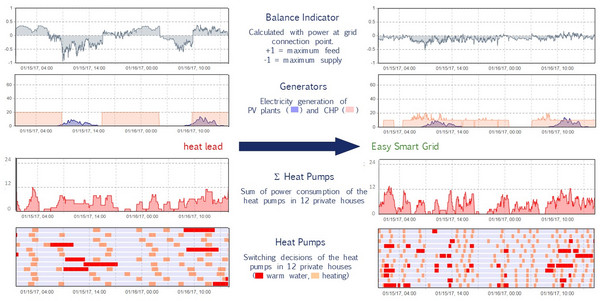
Figure 9 shows how SoLAR enables control of devices that could not be integrated with conventional energy management systems that are based on operating schedules and aggregation: While fridges and freezers by principle are flexible, their small energy storage capacity and short temporal flexibility prevent their participation in electricity markets. In a real-time price environment, however, they can contribute to grid stability. BSH Hausgeraete GmbH provides a fridge/freezer to each household in the SoLAR project to validate this effect. The simulation of 48 devices shows these appliances shifting their operation as a “swarm” to support system objectives while avoiding unwanted synchronisation. They smoothen power balance at the grid connection point: As CHP switches on (marked in red) they react by maximising power consumption and thus dampen the
Figure 9
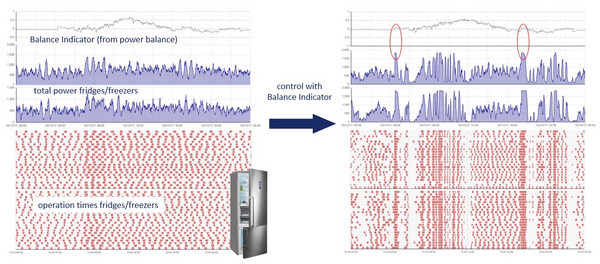
Researchers at DFKI (the German Research Centre for Artificial Intelligence) in Bremen have quantitively assessed and visualised the grid stabilisation effect by fridges for SoLAR (Figure 10): Short-term power fluctuations are reduced by 10% relative to moving average. According to BSH, in Germany alone 2.4 GW of short term “control power” could be provided by cooling appliances, while the European grid has a total primary control power of 3 GW. With intelligent sector coupling, cooling appliances could contribute low cost and carbon-free primary control power.
Figure 10
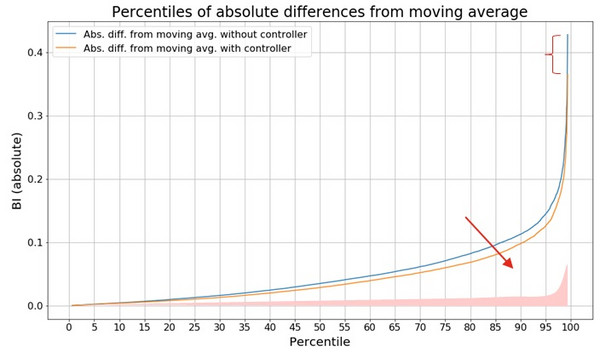
The simulation is currently extended to include flexible devices without energy buffer such as electric vehicle charging points, dishwashers, washing machines and dryers. We now also work on implementation controls in the demo site. Figure 11 shows the control concept.
The balance indicator is centrally obtained at the site grid connection point and transmitted to the controls of CHP, EV charging points and appliances in the apartment buildings. For the semi-detached houses, the central price signal is combined with one for the individual house in order to maximize self-consumption with electricity generated within that house. Then it is communicated to the controls of heat pumps and household appliances, to benefit from additional privileges for self-consumption in individual households granted by German regulation.
Figure 11
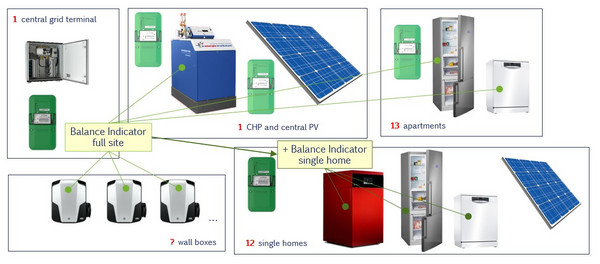
The actual implementation of ICT (information and communication technology) in the demo site by ISC Konstanz is shown in Figure 12. Generation of price signal (balance indicator BI) and appliance control (marked “C” for controller) are performed by Kunbus RevPi microcontrollers connected via Ethernet, obtaining state variables of relevant grid nodes from Smart Meter Gateways (SMGw). Communication to CHP and heat pumps is achieved via Modbus RTU by serial interfaces. Electric vehicle charging points are connected via Ethernet, and flexible household appliances are interfaced by central servers of HomeConnect (BSH) and Miele@home (Miele) via Internet, respectively. Household appliances are connected to the Internet via Wifi, controllers by cable.
Figure 12
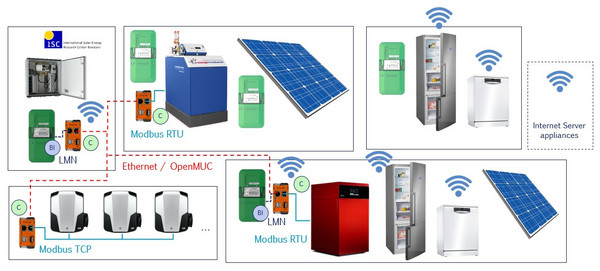
The demo uses existing components which means that its ICT implementation needs additional controllers, cabling and various interfaces. Appliance connection to the Internet via central servers may become disturbed and has limited access rates such that especially for cooling devices control compromises had to be made. Figure 13 therefore suggests how an optimized ICT system could look like.
Figure 13
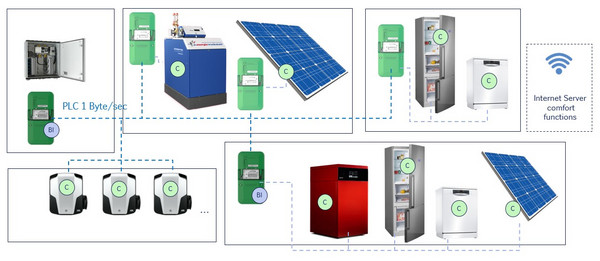
Price signals are created directly in smart meters (BI) and communicated via power line (PLC). The required data rate of ~1Byte/sec can be implemented at low cost and high reliability without additional cabling and different interfaces. Simple PLC receivers can be integrated in the appliances and pass the information to their controllers (C) where it is translated into commands. The Internet is used (if at all) for non-critical comfort functionality. Grid operator commands to curtail PV (as prescribed in Germany) are implemented with the same system. Integration into local energy management systems (HEMS) is also possible.
Conclusion
The development and implementation of intelligent energy sector coupling in a virtual demonstrator and real demo site within SoLAR show that climate neutral energy supply with 100% renewables is possible. The main remaining challenge of energy system transformation – volatile generation from sun and wind cannot follow the load profile of consumers – is solved by maximum use of temporal flexibility in the operation of energy consumers and flexible CHP. The extension of intelligent energy sector coupling to seasonal storage e.g. by hydrogen electrolysis needs further analysis.
Integration of the necessary ICT into hard- and firmware of smart meters and appliance controls allows to minimize unit cost such that flexibility becomes available at very low cost. At the same time the system maximizes resilience within the framework of a “cellular” approach and offers maximum protection for private data and against cyber-attacks.
Figure 14
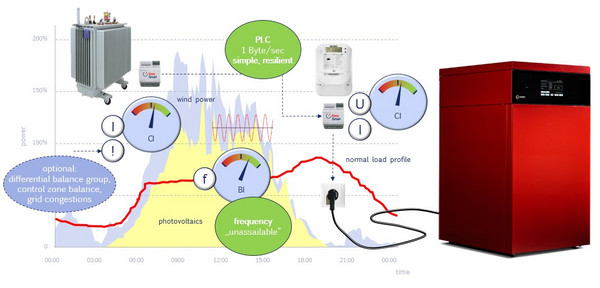
A „Plug and Play“ system can be realized by direct use of grid frequency (f) to derive a price signal, or/and creation and communication of price signals from voltage (U), current (I) or power balances via PLC. Central commands in a perturbed grid situation can be received from grid operators via their local distribution stations, and relayed via PLC to end customers (see figure 14).
In a next demonstration step the city utility of Hassfurt, an associated partner of SoLAR serving 13,000 inhabitants, will use the technology to maximize self-consumption of renewables in a complete distribution grid. Within this context, proposals for the evolution of today’s tariff system will be derived to make it more dynamic and future-proof.
